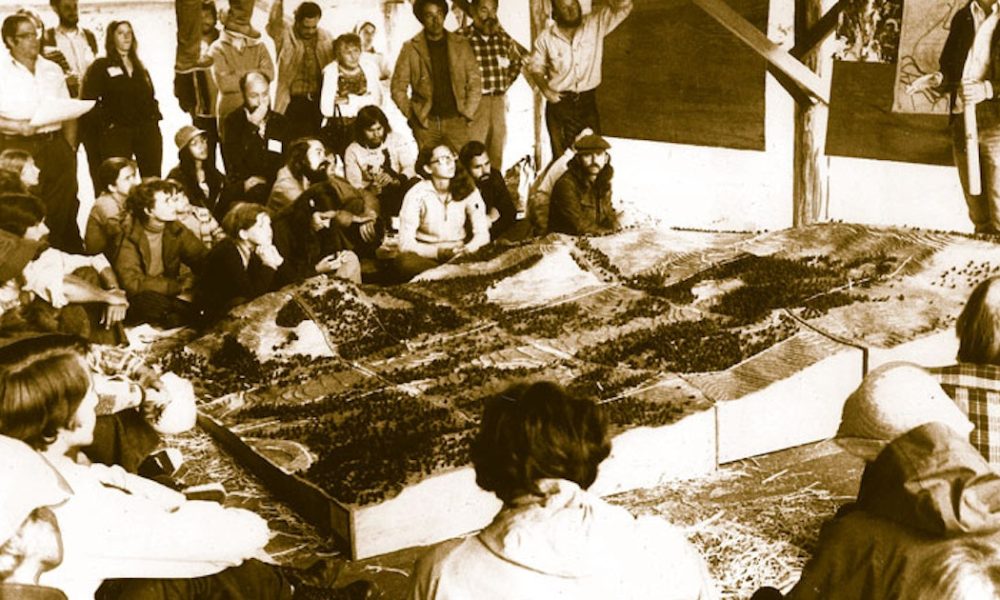 CHRIS CANFIELD AND FOLLOWERS GATHER ON CERRO GORDO WITH A MODEL OF THEIR COMMUNITY. Photo provided/Dana Merryday
CHRIS CANFIELD AND FOLLOWERS GATHER ON CERRO GORDO WITH A MODEL OF THEIR COMMUNITY. Photo provided/Dana Merryday
There seems to be some doubt as to exactly how the highest butte in these parts got the Spanish name ”Cerro Gordo.” The mountain is clearly visible from Main Street in downtown Cottage Grove. Local historian Dr. Oglesby, in a 1919 Sentinel article, laid the blame of the naming the ”fat hill” at the door of Terrence McMurray.
This settler had the original land grant and homesteaded that area. He had also fought in the 1847 Mexican-American War and the mountain reminded him of the same named site of one of that war’s most decisive battles, Cerro Gordo. Other names associated with the mountain are Rattlesnake Hill and Fat Sarah. For more particulars please consult the very excellent web article ”How Cerro Gordo Mt. was named,” by Stephen Williamson.
In 1974 a visionary group of people began to gather in Cottage Grove, inspired by the desire to leave their cars behind and form a close knit ”Ecovillage.” Led by Chris Canfield, this group of pilgrims had been drawn from several sources. Fueled by the younger generation’s dissatisfaction with the American dream and the post 60’s hangover, this group could be roughly put with the ”back to the land” movement. Notices were placed in several publications that reached out to the new age, forward thinking of the time, Mother Earth News, Communities, and surprisingly, Psychology Today.
I talked with several who pulled up their stakes and moved to Cottage Grove to be a part of this vision. One of those, Chuck Missar, laughed when I asked if he could distill his experiences to meet this column’s word limit. ”Books have been written on Cerro Gordo; I wouldn’t know how to boil it down,” he said. He and his wife decided to stay on in Cottage Grove when they realized that the dream they came here for would not likely happen. ”We liked it here,” Chuck told me.
Don Nordin, another resident drawn to Cottage Grove because of Cerro Gordo, explained more of what forces drew the people here and why the land at Cerro Gordo was chosen. Through various focus groups scattered across the country and the aforementioned publications, like minded people answered the call of chief organizer Chris Canfield.
There were certain guiding principles those coming together had subscribed to. The community was to be auto free and limited to a population of 2500, due to a psychologically appealing quality. This number gave the members the ability to recognize each and every one of the community, thus feeling safe. Also fundamentally agreed upon was environmental reverence for the land by using no poisons; organic gardening, bicycles, public transportation, recycling, and solar power were envisioned, as well as areas of natural preserves.
”The land at Cerro Gordo was south facing, so that was ideal for Solar energy,” said Nordin. ”Another attribute of the site was the transportation possibilities due to being near the I-5 corridor and, at the time, having an active local railroad, ”The Goose” (Oregon Pacific & Eastern Railroad).”
The railroad had a stop at Cerro Gordo. Also the land was available. ”It was 1200 acres basically undeveloped, just a burned out homestead, a barn and a couple of old cars and the price was $400,000. Five backers came up with the down payment and people pooled resources,” Nordin recalled.
But as future Cerro Gordo hopefuls gathered, several forces rose to block them. One was Oregon Senate Bill 100, signed into law the year before. Guided by Governor Tom McCall, this legislation sought to put the brakes on the reckless development of farmlands and forests into subdivisions and 2nd home developments. While the legislation got sorted out, the group was delayed from beginning what was hoped to be the self-supporting community planned for Cerro Gordo. There was also resistance from within the close knit timber town of Cottage Grove and its surrounds.
Unfortunately space doesn’t begin to allow me to lead you through the twists and turns of the journey of the land on Cerro Gordo. Suffice to say, most of it is now on its way to being to be preserved as a natural treasure, home to rare indigenous plants. Also a small community of houses are on the property as well as sites for more structures possible. There is also some lasting legacy of the vision of fewer cars in the LTD 98 Bus service hard fought for by some of those who came to live at Cerro Gordo.
A number of people settled in Cottage Grove because they were drawn here, adding their views and becoming active in the community. Some became involved with the development of the Row River Bike Trail. Nearly a thousand acres are being protected in a natural state, that in itself an accomplishment for the group that didn’t want to see everything paved over.
If you would like to learn what has become of the Dream at Cerro Gordo come to the Coast Fork Willamette Watershed Council’s Science Pub, Tuesday Nov. 27, 5 p.m. to 7 p.m. at Cottage Grove’s Axe & Fiddle on Main Street. Come earlier if you want to get a seat as it will fill up fast. The talk is entitled ”Cerro Gordo: From Community to Conservation.”
Learn more at https://www.facebook.com/events/1052510864912201/
Contact Dana Merryday at 541-942-7037 or by emailing [email protected].








